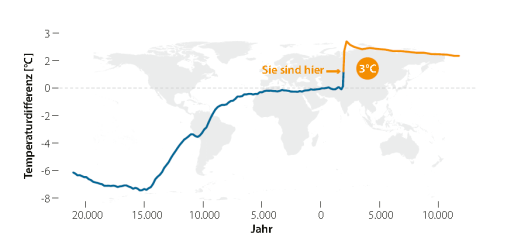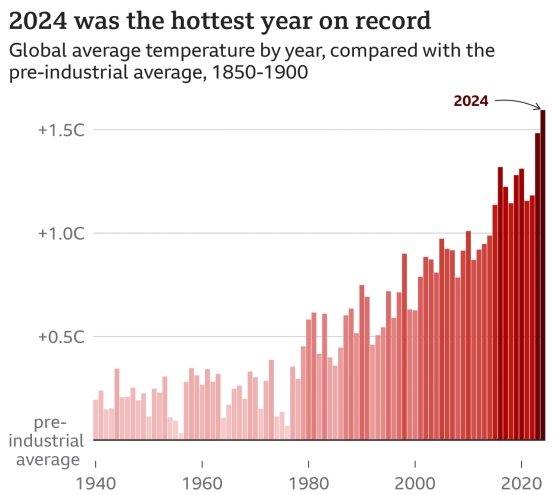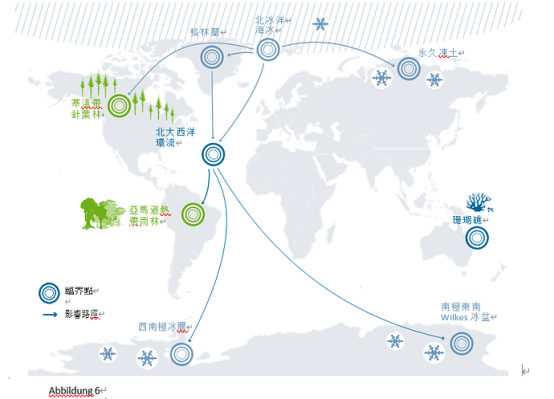Climate Change: What Does a Global Temperature Rise of 3°C Mean for Us?

According to estimates by the Intergovernmental Panel on Climate Change (IPCC), global temperatures have risen by 1.1°C compared to the late 19th century, while the warming limit set by the Paris Agreement is 1.5°C. We can already see the negative impacts of global warming, and faced with such a dire reality, I can't help but wonder: what will it be like if global temperatures rise by 3°C?
Lessons from the Past
The last time the Earth's temperature increased this significantly dates back to the Pliocene epoch, about 3 million years ago. At that time, our ancestors—the australopithecines—had not fully adapted to life on land, indicating that most of the species living on Earth today have not biologically experienced such dramatic warming, potentially leading to the extinction of many species. Based on data from ice cores and sediment samples, we can accurately reconstruct temperature trends over approximately 15,000 years since the last glacial period began to warm. This data shows that current temperatures are the highest in human history since the Holocene, and the current rate of warming is ten times that of the natural warming speed from the Ice Age to the Holocene. Therefore, without strong measures to reduce carbon emissions, we may not see another Ice Age for the next 50,000 years.

What is Climate Change?
Climate change refers to long-term changes in the Earth's average temperature and climate conditions. Over the past century, global temperatures have risen rapidly, and weather patterns have changed accordingly. According to data from the European Copernicus Climate Service, from 2015 to 2024, the average global temperature is about 1.28 degrees Celsius higher than at the end of the 19th century. The UK Met Office states that every decade since the 1980s has been warmer than the previous decade. The year 2024 is projected to be the hottest year on record, and climate change is the primary cause of these high temperatures.

A 3°C Increase? No, It's Actually a 6°C Increase
Seventy percent of the weight of global temperatures comes from the oceans, which have a much higher heat capacity than land. If global temperatures rise by 3°C, land temperatures could effectively reach 6°C. In 2020, I saw reports indicating that land temperatures had already risen by 2°C, a grim reality that often leaves me feeling uneasy.
Deadly Heat
Imagine if temperatures were to rise by 6°C; we could endure temperatures as high as 45°C or even higher. In the summer of 2003, a heatwave in Europe claimed the lives of about 70,000 people. At such high temperatures, the human body's sweating mechanism is significantly affected, especially in high humidity, where the air cannot effectively absorb moisture. This crisis not only impacts health but can even lead to loss of life. In some areas, it is explicitly prohibited to work outdoors between 10 AM and 3 PM during the summer, which makes me acutely aware of the direct threats posed by climate change.
Extreme Drought and Rainfall
Overall, temperature trends are still linearly rising with carbon emissions. However, in other aspects, the effects of warming are more severe. A representative example is the change in the air's capacity to carry water vapor; air's saturation with water increases exponentially with rising temperatures (increasing by 7% for each 1°C rise). Because changes in air humidity are relatively minor compared to temperature variations, the added water saturation can become an invisible water bag, absorbing moisture that should remain on the ground. California's perennial wildfires are due to high temperatures causing excessive water vapor absorption in the air, leading to drought on the surface. Extreme drought has become increasingly frequent over the past forty years, devastating important agricultural areas. In 2010, Russia faced crop failures due to drought and wildfires, forcing it to halt exports. This led to skyrocketing food prices in North Africa and triggered the Arab Spring the following year. Similarly, when temperatures drop, air saturation can decrease exponentially, resulting in heavy rainfall from previously absorbed water vapor. Especially when there are drastic temperature drops in summer, high-saturation air must release a significant amount of moisture in a short period, easily leading to floods. Beyond extreme weather, atmospheric activities have become increasingly chaotic in recent years.
Melting Ice Caps and Rising Sea Levels
During the Pliocene epoch, around 3 million years ago, sea levels were 5-25 meters higher than they are now, as there was no ice. By the peak of the last Ice Age about 20,000 years ago, sea levels were about 120 meters lower than today. If the vast ice sheets covering Antarctica and Greenland were to completely melt, global sea levels could rise by a staggering 65 meters. Currently, sea levels have risen by about 20 centimeters compared to the late 19th century. This has already resulted in significant negative impacts, not just from storm surges leading to saltwater intrusion but also causing intermittent flooding. In some areas along the U.S. East Coast, this phenomenon is referred to as "nuisance flooding." Available data suggests that the rate of sea-level rise is linearly related to its increase. If temperatures rise by 3°, the speed of sea-level rise will be three times faster than it is now, due to accelerated ice melting. Since 2020, the rise in sea level has indeed been accelerating, with ice caps melting and slowly sliding into the ocean.

The Domino Effect of Global Climate System Collapse
Within the global climate system, there are numerous critical points similar to the melting of the Greenland ice sheet. Once a certain threshold is reached, existing negative trends will become irreversible. If temperatures rise by 3°, not only is it almost certain that the Greenland and Arctic sea ice will disappear, but the world’s coral reefs will also face extinction. The IPCC even believes that a mere 2° increase in temperature will lead to the disappearance of all coral reefs globally; if we can achieve the Paris Agreement target of only a 1.5° rise, we may still save 10-30% of coral reefs. Since 2015, global coral reefs have begun to die off progressively.
Potential Disappearance of the Atlantic Meridional Overturning Circulation
Also at risk is the Atlantic Meridional Overturning Circulation (AMOC), commonly known as the Gulf Stream. This ocean current system is critically important for the Atlantic basin, responsible for distributing water from the South Atlantic through the equator to the high latitudes of the North Atlantic. Cold water decreases in temperature and increases in salinity, allowing it to sink and eventually return to the Caribbean Sea to complete the cycle. This system is vital for the climate of the North Atlantic and Europe, but it has become increasingly unstable due to the excess freshwater caused by extreme changes and ice melting.
How Will Future Climate Change Affect the World?
The more severe global warming becomes, the more serious the impacts of climate change will be. According to United Nations data, potential consequences of a 2°C increase in global temperatures compared to 1.5°C include:
- Average temperatures in mid-latitude regions (excluding polar and tropical regions) could rise by 4°C, leading to extreme heat;
- Sea level rise could be about 0.1 meters higher than at 1.5°C, putting up to 10 million people at risk of flooding;
- Over 99% of the world's coral reefs could vanish, compared to 70-90% at 1.5°C;
- Over half of geographic areas may have twice the number of plants and vertebrates exposed to unsuitable climate conditions;
- By 2050, the number of people affected by climate-related risks and falling into poverty could increase by hundreds of millions.
One of the reasons for calling to limit the temperature rise to within 1.5°C is to avoid crossing so-called "tipping points." Once these tipping points are exceeded, changes will accelerate and become irreversible. For example, the collapse of the Greenland ice sheet would have extremely serious consequences.
Adapting to the Future with Data, Artificial Intelligence, and Technology
Experts emphasize one certain fact: our planet is moving toward an era centered around electricity, especially renewable energy. “Our transportation will be powered by electricity; our cooking will be powered by electricity; our heating will be powered by electricity. Therefore, if we do not have a reliable electricity system, everything will collapse. When considering how to change our energy systems and the reliability and resilience of future energy systems, we need this climate intelligence.”
In fact, to adapt to this change, both experts emphasize the need for what is called climate-smart planning—integrating climate forecasts, data, and science into energy planning at all levels. For instance, in Chile, due to abnormally high rainfall, hydropower generation surged by 80% in November 2023. Though this increase was driven by climate factors, experts say advanced seasonal forecasting can help dam operators better predict similar future events and manage reservoirs to store water more effectively. Similarly, wind farm workers can use forecasts to schedule maintenance during low wind periods, thus minimizing downtime and avoiding losses. Grid operators can also develop peak energy plans during heatwaves or droughts. Artificial intelligence (AI) is helping: machine learning models trained on climate and energy data can now forecast resource fluctuations with higher resolution and accuracy. These tools can optimize when to deploy battery storage or shift energy between regions, making systems more flexible and responsive.
What Can Individuals Do About Climate Change?
In the face of such challenges, individual actions are equally important. While true transformation must come from governments and businesses, I can also contribute to combating climate change through some simple actions, such as:
- Reducing flight travel;
- Using less energy;
- Improving insulation and energy efficiency in homes;
- Switching to electric vehicles or living car-free;
- Replacing gas central heating with electric systems like heat pumps;
- Eating less red meat.

Feel free to use XXAI to learn more about related knowledge.
Looking Ahead
As the world competes to move towards a renewable energy-driven future, it is imperative to address the challenges posed by climate change. The events of 2023 remind us once again of the necessity for climate-smart planning and infrastructure. I believe that by integrating climate intelligence and utilizing advanced forecasting technologies, we can better adapt to changes and ensure that renewable energy functions reliably and effectively. Only in this way can we build a more resilient and adaptable future, creating better living conditions for future generations. I hope everyone recognizes the urgency of climate change and works together to tackle this significant challenge that impacts our future.